2018 NISSAN NV PASSENGER VAN roof
[x] Cancel search: roofPage 11 of 426
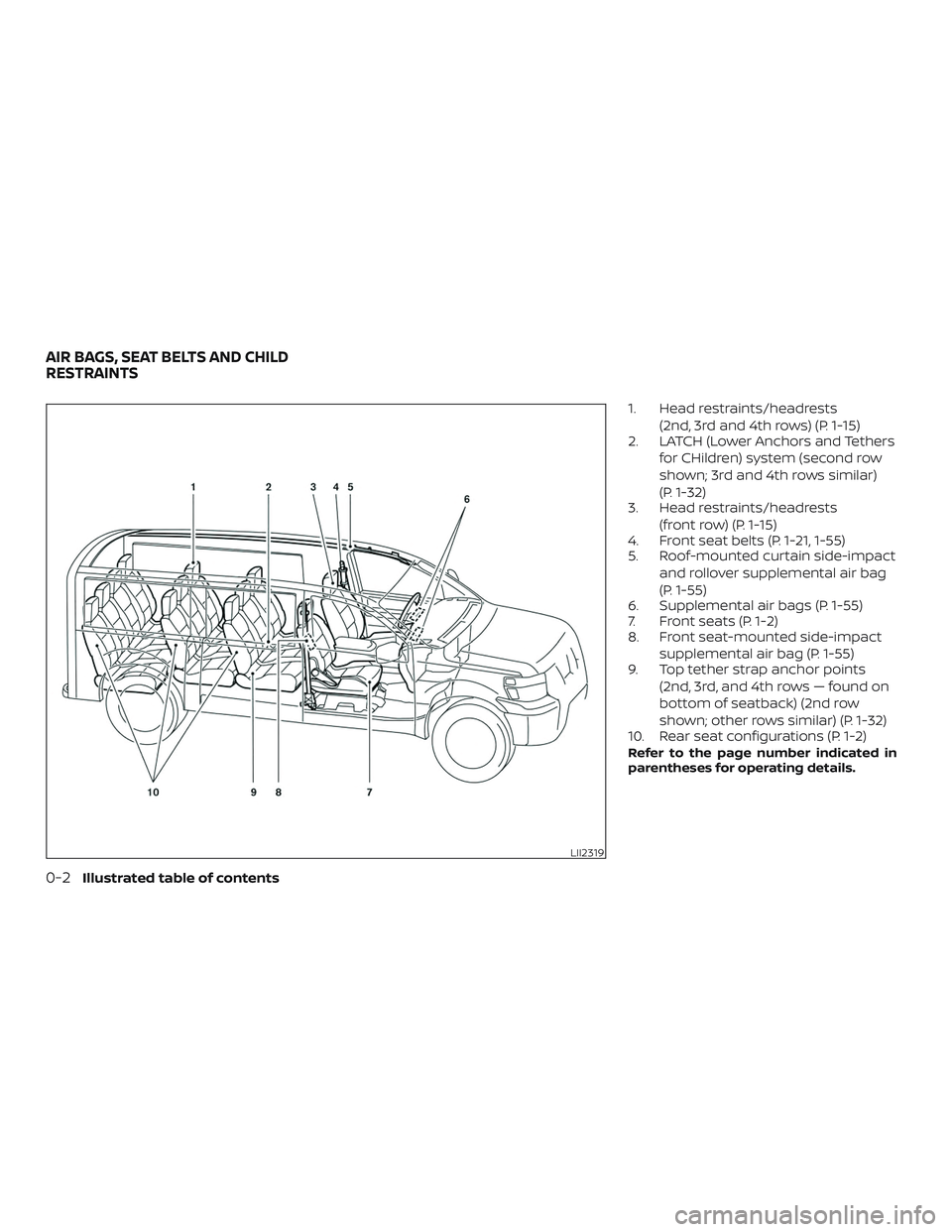
1. Head restraints/headrests(2nd, 3rd and 4th rows) (P. 1-15)
2. LATCH (Lower Anchors and Tethers
for CHildren) system (second row
shown; 3rd and 4th rows similar)
(P. 1-32)
3. Head restraints/headrests
(front row) (P. 1-15)
4. Front seat belts (P. 1-21, 1-55)
5. Roof-mounted curtain side-impact
and rollover supplemental air bag
(P. 1-55)
6. Supplemental air bags (P. 1-55)
7. Front seats (P. 1-2)
8. Front seat-mounted side-impact
supplemental air bag (P. 1-55)
9. Top tether strap anchor points
(2nd, 3rd, and 4th rows — found on
bottom of seatback) (2nd row
shown; other rows similar) (P. 1-32)
10. Rear seat configurations (P. 1-2)
Refer to the page number indicated in
parentheses for operating details.
LII2319
AIR BAGS, SEAT BELTS AND CHILD
RESTRAINTS
0-2Illustrated table of contents
Page 76 of 426

PRECAUTIONS ON SRS
This SRS section contains important infor-
mation concerning the following systems:∙ Driver and front passenger supple- mental front-impact air bag
∙ Front seat-mounted side-impact supplemental air bag
∙ Roof-mounted curtain side-impact and rollover supplemental air bag
∙ Seat belt with pretensioner(s) (front seats)
Supplemental front-impact air bag
system
This system can help cushion the impact
force to the head and chest of the driver
and front passenger in certain frontal colli-
sions.
Front seat-mounted side-impact
supplemental air bag system
This system can help cushion the impact
force to the chest and pelvic area of the
driver and front passenger in certain side
impact collisions. The side air bags are de-
signed to inflate on the side where the ve-
hicle is impacted. Roof-mounted curtain side-impact and
rollover supplemental air bag system
This system can help cushion the impact
force to the head of occupants in front and
rear outboard seating positions in certain
side-impact or rollover collisions. In a side
impact, the curtain air bags are designed
to inflate on the side where the vehicle is
impacted. In a rollover, both curtain and air
bags are designed to inflate and remain
inflated for a short time.
This supplemental restraint system is de-
signed to
supplement the crash protec-
tion provided by the driver and front pas-
senger seat belts and is not a substitute
for them. Seat belts should always be cor-
rectly worn and the occupant seated a
suitable distance away from the steering
wheel, instrument panel and door finishers.
For additional information, refer to “Seat
belts” in this section.
The supplemental air bags operate only
when the ignition switch is placed in the
ON or START position. Af ter placing the ignition switch in the
ON position, the supplemental air bag
warning light illuminates. The supple-
mental air bag warning light will turn off
af ter about 7 seconds if the system is
operational.
SUPPLEMENTAL RESTRAINT SYSTEM
(SRS)
Safety—Seats, seat belts and supplemental restraint system1-55
Page 80 of 426

WARNING
∙ Children may be severely injured orkilled when the front air bags, side air
bags or curtain side-impact rollover
air bags inflate if they are not properly
restrained. Pre-teens and children
should be properly restrained in the
rear seat, if possible.
∙ Never install a rear-facing child re- straint in the front seat. An inflating
front air bag could seriously injure or
kill your child. For additional informa-
tion, refer to “Child restraints” in this
section.WARNING
Front seat-mounted side-impact
supplemental air bags and roof-
mounted curtain side-impact rollover
supplemental air bags:
∙ The side air bags and curtain air bagsordinarily will not inflate in the event
of a frontal impact, rear impact or
lower severity side collision. Always
wear your seat belts to help reduce
the risk or severity of injury in various
kinds of accidents.
ARS1045ARS1046Do not lean against doors or windows.
WRS0431
Safety—Seats, seat belts and supplemental restraint system1-59
Page 81 of 426
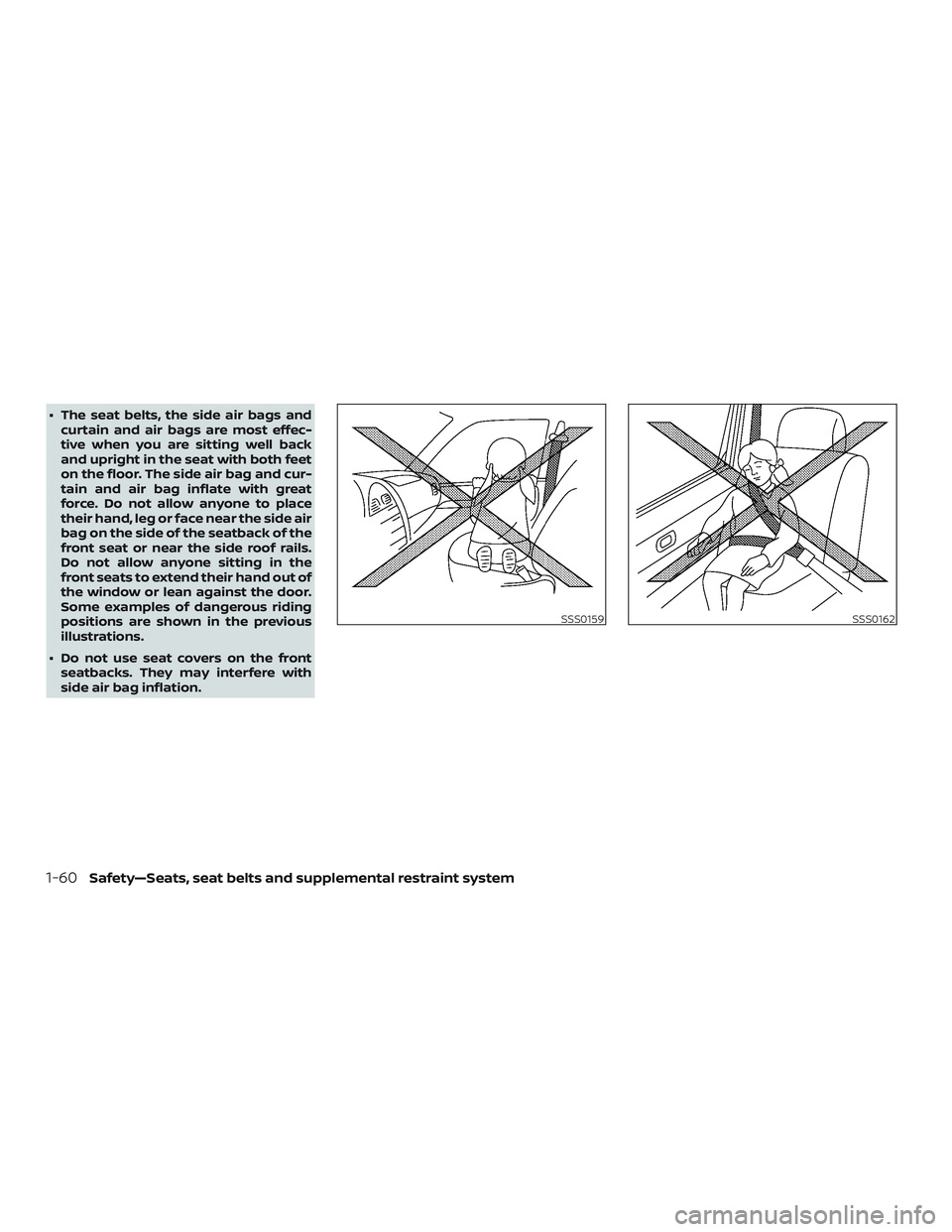
∙ The seat belts, the side air bags andcurtain and air bags are most effec-
tive when you are sitting well back
and upright in the seat with both feet
on the floor. The side air bag and cur-
tain and air bag inflate with great
force. Do not allow anyone to place
their hand, leg or face near the side air
bag on the side of the seatback of the
front seat or near the side roof rails.
Do not allow anyone sitting in the
front seats to extend their hand out of
the window or lean against the door.
Some examples of dangerous riding
positions are shown in the previous
illustrations.
∙ Do not use seat covers on the front seatbacks. They may interfere with
side air bag inflation.
SSS0159SSS0162
1-60Safety—Seats, seat belts and supplemental restraint system
Page 82 of 426
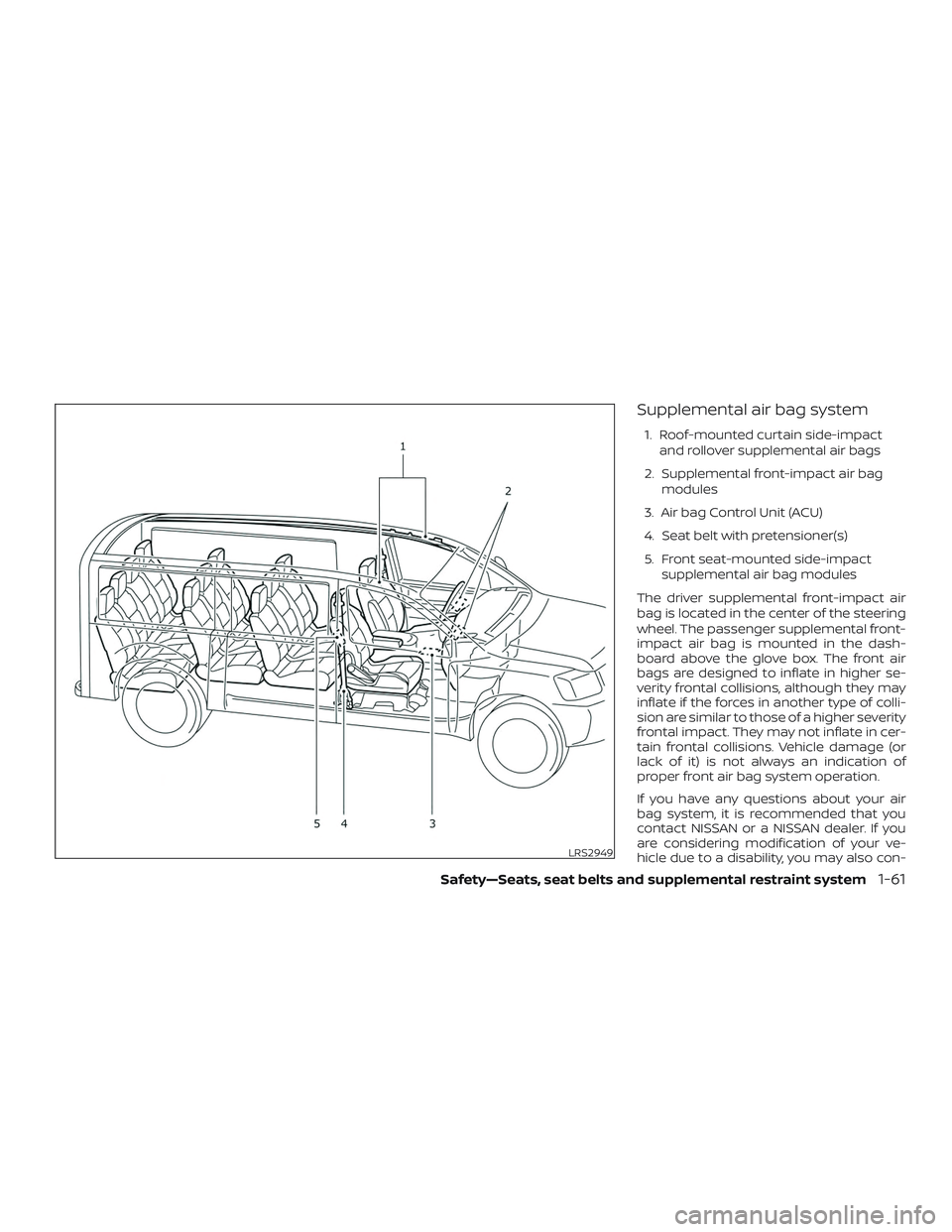
Supplemental air bag system
1. Roof-mounted curtain side-impactand rollover supplemental air bags
2. Supplemental front-impact air bag modules
3. Air bag Control Unit (ACU)
4. Seat belt with pretensioner(s)
5. Front seat-mounted side-impact supplemental air bag modules
The driver supplemental front-impact air
bag is located in the center of the steering
wheel. The passenger supplemental front-
impact air bag is mounted in the dash-
board above the glove box. The front air
bags are designed to inflate in higher se-
verity frontal collisions, although they may
inflate if the forces in another type of colli-
sion are similar to those of a higher severity
frontal impact. They may not inflate in cer-
tain frontal collisions. Vehicle damage (or
lack of it) is not always an indication of
proper front air bag system operation.
If you have any questions about your air
bag system, it is recommended that you
contact NISSAN or a NISSAN dealer. If you
are considering modification of your ve-
hicle due to a disability, you may also con-
LRS2949
Safety—Seats, seat belts and supplemental restraint system1-61
Page 84 of 426
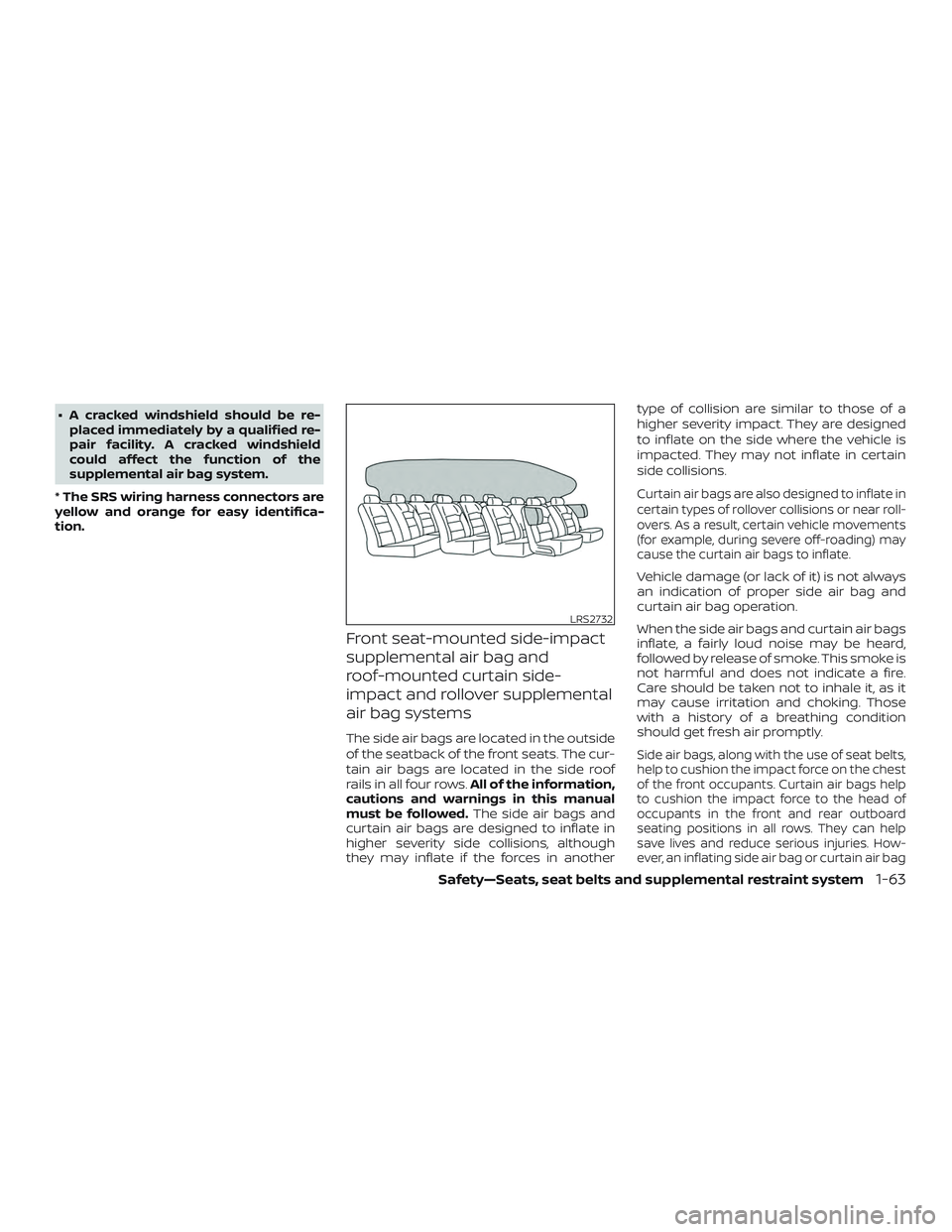
∙ A cracked windshield should be re-placed immediately by a qualified re-
pair facility. A cracked windshield
could affect the function of the
supplemental air bag system.
* The SRS wiring harness connectors are
yellow and orange for easy identifica-
tion.
Front seat-mounted side-impact
supplemental air bag and
roof-mounted curtain side-
impact and rollover supplemental
air bag systems
The side air bags are located in the outside
of the seatback of the front seats. The cur-
tain air bags are located in the side roof
rails in all four rows. All of the information,
cautions and warnings in this manual
must be followed. The side air bags and
curtain air bags are designed to inflate in
higher severity side collisions, although
they may inflate if the forces in another type of collision are similar to those of a
higher severity impact. They are designed
to inflate on the side where the vehicle is
impacted. They may not inflate in certain
side collisions.
Curtain air bags are also designed to inflate in
certain types of rollover collisions or near roll-
overs. As a result, certain vehicle movements
(for example, during severe off-roading) may
cause the curtain air bags to inflate.
Vehicle damage (or lack of it) is not always
an indication of proper side air bag and
curtain air bag operation.
When the side air bags and curtain air bags
inflate, a fairly loud noise may be heard,
followed by release of smoke. This smoke is
not harmful and does not indicate a fire.
Care should be taken not to inhale it, as it
may cause irritation and choking. Those
with a history of a breathing condition
should get fresh air promptly.
Side air bags, along with the use of seat belts,
help to cushion the impact force on the chest
of the front occupants. Curtain air bags help
to cushion the impact force to the head of
occupants in the front and rear outboard
seating positions in all rows. They can help
save lives and reduce serious injuries. How-
ever, an inflating side air bag or curtain air bag
LRS2732
Safety—Seats, seat belts and supplemental restraint system1-63
Page 85 of 426

may cause abrasions or other injuries. Side air
bags and curtain air bags do not provide re-
straint to the lower body.
The seat belts should be correctly worn
and the driver and passenger seated up-
right as far as practical away from the side
air bag. Rear seat passengers should be
seated as far away as practical from the
door finishers and side roof rails. The side
air bags and curtain air bags inflate quickly
in order to help protect the occupants. Be-
cause of this, the force of the side air bags
and curtain air bags inflating can increase
the risk of injury if the occupant is too close
to, or is against, these air bag modules dur-
ing inflation. The side air bag will deflate
quickly af ter the collision is over.
The curtain air bag will remain inflated for a
short time.
The side air bags and curtain air bags
operate only when the ignition switch is
placed in the ON or START position.
Af ter placing the ignition switch in the
ON position, the supplemental air bag
warning light illuminates. The supple-
mental air bag warning light will turn off
af ter about 7 seconds if the system is
operational.
WARNING
∙ Do not place any objects near theseatback of the front seats. Also, do
not place any objects (an umbrella,
bag, etc.) between the front door fin-
isher and the front seat. Such objects
may become dangerous projectiles
and cause injury if a side air bag
inflates.
∙ Right af ter inflation, several side air bag and curtain air bag system com-
ponents will be hot. Do not touch
them; you may severely burn yourself.
∙ No unauthorized changes should be made to any components or wiring of
the side air bag and curtain air bag
systems. This is to prevent damage to
or accidental inflation of the side air
bag and curtain air bag systems.
∙ Do not make unauthorized changes to your vehicle’s electrical system,
suspension system or side panel. This
could affect proper operation of the
curtain air bag systems. ∙ Tampering with the side air bag sys-
tem may result in serious personal in-
jury. For example, do not change the
front seats by placing material near
the seatbacks or by installing addi-
tional trim material, such as seat cov-
ers, around the side air bag.
∙ It is recommended that you visit a NISSAN dealer for work around and on
the side air bag and curtain air bag
systems. It is also recommended that
you visit a NISSAN dealer for installa-
tion of electrical equipment. The SRS
wiring harnesses* should not be
modified or disconnected. Unauthor-
ized electrical test equipment and
probing devices should not be used
on the side air bag or curtain air bag
systems.
* The SRS wiring harness or connectors
are yellow or orange for easy identifica-
tion.
When selling your vehicle, we request that
you inform the buyer about the side air
bags and curtain air bag system and guide
the buyer to the appropriate sections in
this Owner’s Manual.
1-64Safety—Seats, seat belts and supplemental restraint system
Page 196 of 426
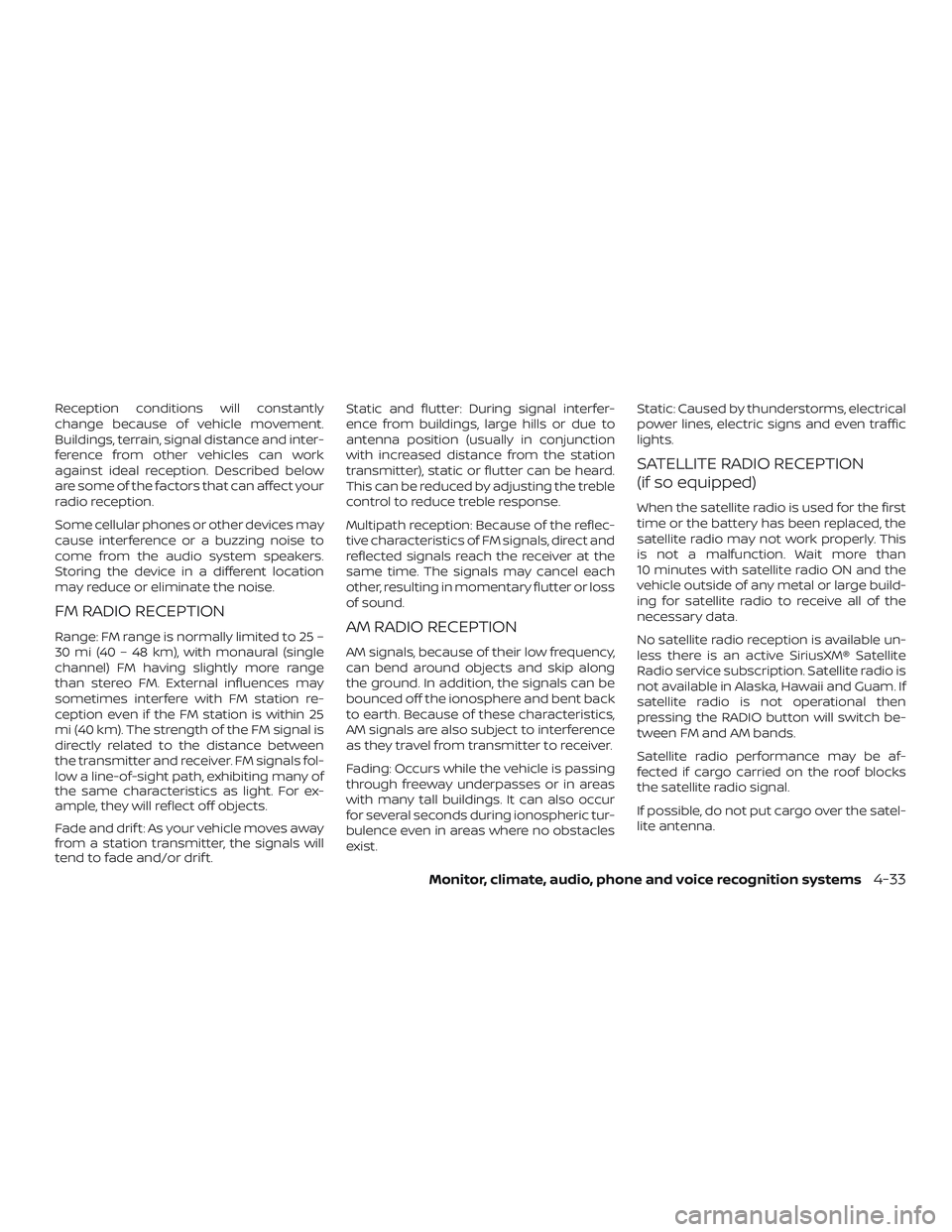
Reception conditions will constantly
change because of vehicle movement.
Buildings, terrain, signal distance and inter-
ference from other vehicles can work
against ideal reception. Described below
are some of the factors that can affect your
radio reception.
Some cellular phones or other devices may
cause interference or a buzzing noise to
come from the audio system speakers.
Storing the device in a different location
may reduce or eliminate the noise.
FM RADIO RECEPTION
Range: FM range is normally limited to 25 –
30 mi (40 – 48 km), with monaural (single
channel) FM having slightly more range
than stereo FM. External influences may
sometimes interfere with FM station re-
ception even if the FM station is within 25
mi (40 km). The strength of the FM signal is
directly related to the distance between
the transmitter and receiver. FM signals fol-
low a line-of-sight path, exhibiting many of
the same characteristics as light. For ex-
ample, they will reflect off objects.
Fade and drif t: As your vehicle moves away
from a station transmitter, the signals will
tend to fade and/or drif t.Static and flutter: During signal interfer-
ence from buildings, large hills or due to
antenna position (usually in conjunction
with increased distance from the station
transmitter), static or flutter can be heard.
This can be reduced by adjusting the treble
control to reduce treble response.
Multipath reception: Because of the reflec-
tive characteristics of FM signals, direct and
reflected signals reach the receiver at the
same time. The signals may cancel each
other, resulting in momentary flutter or loss
of sound.AM RADIO RECEPTION
AM signals, because of their low frequency,
can bend around objects and skip along
the ground. In addition, the signals can be
bounced off the ionosphere and bent back
to earth. Because of these characteristics,
AM signals are also subject to interference
as they travel from transmitter to receiver.
Fading: Occurs while the vehicle is passing
through freeway underpasses or in areas
with many tall buildings. It can also occur
for several seconds during ionospheric tur-
bulence even in areas where no obstacles
exist.
Static: Caused by thunderstorms, electrical
power lines, electric signs and even traffic
lights.
SATELLITE RADIO RECEPTION
(if so equipped)
When the satellite radio is used for the first
time or the battery has been replaced, the
satellite radio may not work properly. This
is not a malfunction. Wait more than
10 minutes with satellite radio ON and the
vehicle outside of any metal or large build-
ing for satellite radio to receive all of the
necessary data.
No satellite radio reception is available un-
less there is an active SiriusXM® Satellite
Radio service subscription. Satellite radio is
not available in Alaska, Hawaii and Guam. If
satellite radio is not operational then
pressing the RADIO button will switch be-
tween FM and AM bands.
Satellite radio performance may be af-
fected if cargo carried on the roof blocks
the satellite radio signal.
If possible, do not put cargo over the satel-
lite antenna.
Monitor, climate, audio, phone and voice recognition systems4-33